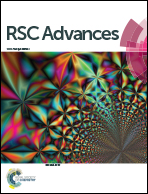Chemically integrated hierarchical hybrid zinc cobaltate/reduced graphene oxide microspheres as an enhanced lithium-ion battery anode†
Abstract
Chemically integrated hierarchical microsphere ZnCo2O4/reduced graphene oxide hybrid composites are synthesized via a polyol process. Microsphere ZnCo2O4 particles embedded in graphene homogeneously with sizes in the region of 320–512 nm, graphene sheets grew and interwove inversely in the inside of the microsphere ZnCo2O4 particles, so that the structure possesses a unique microsphere–sheet hybrid structure. The interconnected graphene conductive network basic skeleton is beneficial to the transportation of Li+ and electrons. Compared with the conventional way metal oxides and graphene combine, hierarchical microsphere ZnCo2O4/reduced graphene oxide hybrid composites exhibit enhanced rate capability (469.7 mA h g−1 at 4000 mA g−1) and long term cycling ability with high capability (904.2 mA h g−1 at 1000 mA g−1 over 500 charge/discharge cycles), owing to the special characteristic of a three-dimensional structure. Most importantly, with the successful synthesis of the hierarchical microsphere ZnCo2O4/reduced graphene oxide hybrid composites, this facile strategy can extend to the synthesis of the ternary transition metal oxides/reduced graphene oxide with hierarchical microsphere structure and make it possible to explore a more promising storage application.


 Please wait while we load your content...
Please wait while we load your content...